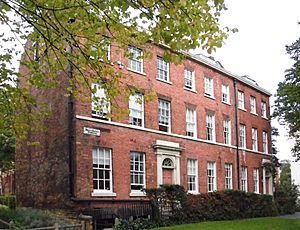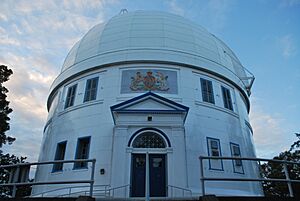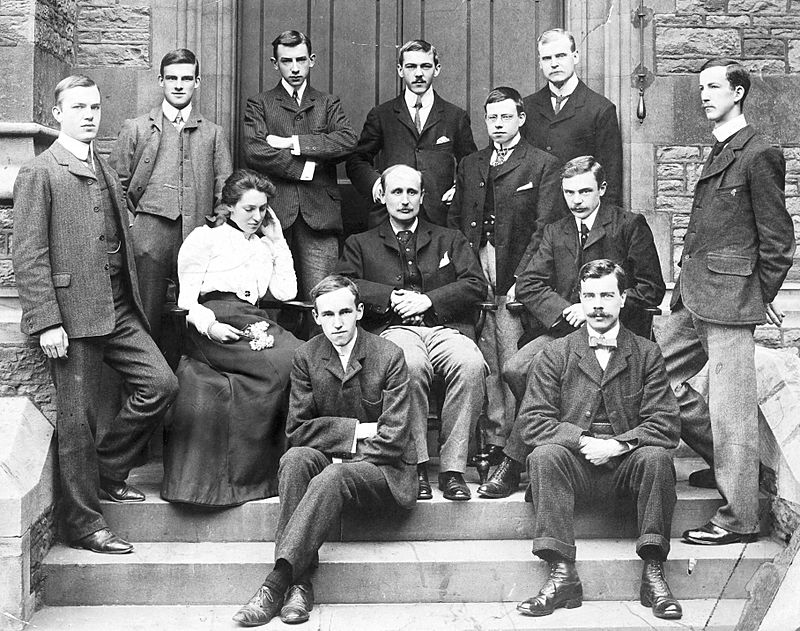Joseph Hubert Priestley facts for kids
Quick facts for kids
Joseph Hubert Priestley
DSO FLS
|
|
|---|---|
|
Priestley at University College, Bristol, in 1902
|
|
| Born |
Joseph Hubert Priestlay
5 October 1883 Tewkesbury, Gloucestershire, England
|
| Died | 31 October 1944 (aged 61) Weetwood, Leeds, West Yorkshire, England
|
| Resting place | Lawnswood crematorium (ashes scattered) |
| Alma mater | University College, Bristol (1903: BSc) |
| Occupation | |
| Relatives |
|
| Awards |
|
| Scientific career | |
| Fields |
Other fields
Secondary growth
Vegetative reproduction |
| Institutions |
|
| Notable students |
|
| Pro-vice-chancellor, University of Leeds | |
| In office 1935–1939 |
|
| Preceded by | Paul Barbier |
| Succeeded by | Matthew John Stewart |
| In office 1941–1941 |
|
| Preceded by | Matthew John Stewart |
| Succeeded by | John David Ivor Hughes |
| Military service | |
| Allegiance | |
| Branch | |
| Service years | 1914–1919 |
| Rank | Captain |
| Corps |
|
| Conflict | World War I |
| Awards |
|
Joseph Hubert Priestley (born October 5, 1883 – died October 31, 1944) was a British scientist. He taught botany at University College, Bristol and later became a professor at the University of Leeds. People said he was a very good teacher who inspired many students.
Joseph was the oldest of eight children. His younger brother, Raymond Priestley, was a famous explorer of the Antarctic. Joseph was educated at his father's school and then at University College, Bristol. In 1904, he became a botany lecturer. He studied how plants use light to make food (called photosynthesis) and how electricity affects them. He also became a member of the Linnean Society of London, a group for naturalists.
In 1911, he became a professor at the University of Leeds. He served as a captain in the British Army during World War I. He was recognized for his bravery and received the Distinguished Service Order (DSO). After the war, he continued his research on how plants grow and form new parts. He also studied how light affects plants and how they reproduce.
Joseph Priestley was a leader at the University of Leeds. He was the dean of the science faculty and later a Pro-vice-chancellor. He loved playing cricket and was captain of the staff team. He passed away in 1944 after a long illness.
Early Life and Family
Joseph Hubert Priestley was born on October 5, 1883, in Tewkesbury, England. His family originally spelled their last name "Priestlay," but it changed to "Priestley" in the early 1900s. His father, Joseph Edward Priestlay, was a head teacher at a school in Tewkesbury.
Joseph had seven brothers and sisters. Two of his brothers, Stanley and Donald, died during World War I. His brother, Raymond Priestley, was a geologist and explorer who went to the Antarctic with Robert Falcon Scott. Joseph's sisters, Edith and Doris, married other members of Scott's expedition.
The Priestley family were Methodists, a type of Christian faith. Joseph and his siblings had to attend church and Sunday school every week. They also loved cricket. Joseph played for his college team and later captained the staff team at the University of Leeds.
Education and Learning
Joseph Priestley went to his father's school in Tewkesbury. He later attended University College, Bristol. Even though he mainly studied botany (the study of plants), he also took classes in chemistry and physics.
In 1901, he received a scholarship to help pay for his studies. In 1903, he earned his Bachelor of Science (BSc) degree with top honors in botany. He also received a special award to study rust fungi, which are tiny plant diseases.
Career and Discoveries

In 1905, Joseph Priestley became a temporary lecturer in botany at University College, Bristol. This job was later made permanent. He and his brother Raymond lived together in a boarding house, often eating simple meals to save money.
Early Research
Priestley's early work focused on photosynthesis, the process where plants use sunlight to make food. He published a paper suggesting that chlorophyll (the green stuff in plants) could create formaldehyde in the presence of light and carbon dioxide. However, other scientists later found that formaldehyde was a byproduct, not the main result of photosynthesis.
He also researched how electricity affects plants. He set up experiments where electrical wires were placed above plants in greenhouses. He noticed that electrified wheat plants looked darker green. He thought this might be because electricity helped add more nitrates (a type of nutrient) to the soil. Today, scientists generally agree that electric fields don't really help plants grow.
Moving to Leeds and War Service

In 1911, Priestley became a professor of botany at the University of Leeds. His work was interrupted by World War I. He had been in charge of the university's military training group. In August 1914, he was sent to France with the British army. For the rest of the war, he worked in the Intelligence Corps. He was recognized twice for his brave actions and received the Distinguished Service Order (DSO) and the "Knight of the Order of the Crown of Belgium" award.
Post-War Research
After returning to Leeds, Priestley started new research projects. He studied:
- The structure and growth of plant tips.
- How light affects plant growth.
- How cork forms on plants.
- Plant propagation, which is how new plants are grown from existing ones.
He was influenced by other scientists who studied plant cell walls and plant shapes.
Leadership Roles

In 1922, Priestley became the dean of the science faculty at the University of Leeds. He was also the first person to be a "warden" for male students, helping them with their social lives. He organized many fun events, including dancing classes and "botanical parties" for students and staff.
He was an active member of several scientific groups, like the British Science Association. He traveled to Canada and South Africa for meetings, even collecting plant samples during his travels. In 1935, he was elected Pro-vice-chancellor of the university, a senior leadership role. He held this position twice.
Personal Life
Joseph Priestley married Marion Ethel Young in Bristol in 1911. Marion was also interested in botany and was a member of the British Mycological Society (a group for mushroom and fungus lovers). She helped organize many social events at the university.
They had two daughters, Phyllis Mary and Ann Elizabeth. Both daughters went to Girton College, Cambridge, and became successful in their own fields. Phyllis Mary's son, Michael Cullen, became a senior research fellow at the Met Office, studying weather.
Death and Legacy
Joseph Priestley passed away on October 31, 1944, after a long illness. His funeral was held in Leeds. Many university staff and representatives from scientific groups attended to honor him. His ashes were scattered in the gardens of the crematorium.
After his death, a special fund was created to help botany students at the University of Leeds. His brother Raymond also set up an annual science prize at Tewkesbury Grammar School in Joseph's memory. Joseph's collection of fossils is now part of the Leeds Discovery Centre.
Even though some of his early research ideas were later updated, Joseph Priestley was known as a brilliant teacher. One of his colleagues wrote that he "inspired many generations of students" and was always ready to help.
Selected Publications
- An Introduction to Botany, with special reference to the structure of the flowering plant (1938) - a textbook he co-wrote.
Research on Plants
- The Effect of Electricity upon Plants (1906)
- Overhead Electric Discharges and Plant Growth (1910)
- A Study of the Mechanism of Carbon Assimilation in Green Plants (1906)
- The Plant Cuticle: I. Its Structure, Distribution, and Function (1924)
- Problems of Vegetative Propagation (1926)
- Radial Growth and Extension Growth in the Tree (1935)
Images for kids
See also
- Jane Ingham
- Irene Manton
- Plant development
- Raymond Priestley
- Adriance Sherwood Foster









